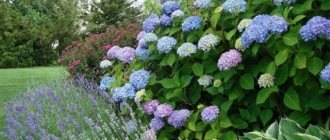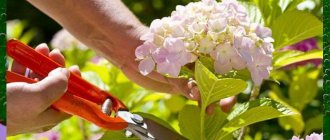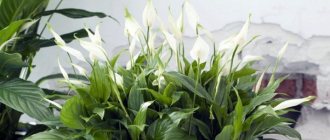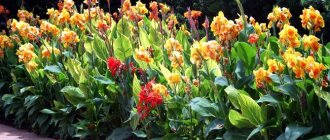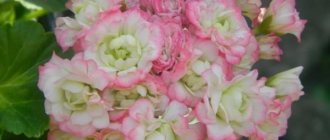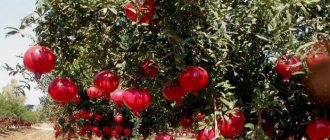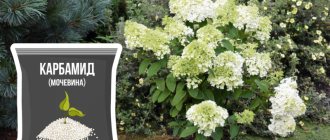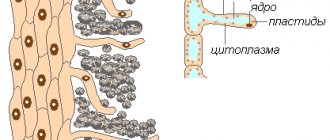Hydrangea: description, photo
The flower got its name for its moisture-loving nature. From Latin the designation “hydrangea” is translated as a combination of “water” and “jug”. Officially, hydrangea is called hydrangea. In Europe, the name was consonant with a common female name, so there were many myths about whom the enamored botanist Fliebert Commerson gave the honor of being the founder of the name of the flower.
There is a popular legend about the Emperor of Japan, who liked the elongated white panicles and used them to apologize to his lady. Since then, the hydrangea variety has come to be personified with cordiality, sincerity of feelings, and a manifestation of complacency.
garden hydrangea
These garden flowers are used as the main element of flower arrangements, borders, and planted in areas to divide space while simultaneously marking the territory with abundant inflorescences of different shades. They coexist with thujas and juniper trees, but do not like to grow in the shade of tall coniferous trees.
Hydrangeas are represented by several species: some of them belong to the shrub type, some grow like trees, and the rest develop like vines. Description of the classic type of hydrangea:
- The stems grow from 1 to 3 m. In some varieties, the height can reach 10 m.
- The leaves are semi-oval with pointed tips. The surface of the leaves is glossy, rich green in color.
- Flowers are collected in inflorescences-corymbs or panicles. The diameter of the inflorescences can reach 20 cm. The shade of the petals depends on the species characteristics. White and pink are considered classic colors.
- After ripening, the fruits are collected in a simple capsule, which is formed at the site of the inflorescence fading.
The genus has several species that differ from each other.
| View | Characteristic |
| tree-like | A shrub that stretches up to 3 m. Small white flowers reach 2 cm in diameter, form scutes up to 20 cm in size. It begins to bloom in mid-summer, feels comfortable in the temperate climate zone. |
| Paniculate | Shrubs or trees stretch up to 10 m. The difference from other subspecies is that small flowers are collected in inflorescences - panicles. |
| large-leaved | The bushes grow up to 4 m. Flowers on thyroid inflorescences can be blue, pink or white. This is the only species that can change the shade of the petal after changing the composition of the earth. Large-leaved hydrangias are often chosen for growing as a houseplant. There are more than 80 varieties of indoor hydrangeas. |
Hydrangea is grown on clubs as a garden type or on a windowsill as a houseplant. Flowering begins with the onset of summer and continues until the autumn cold. The inflorescences, corymbs or panicles, make the hydrangea visible from afar. The shades of the petals attract gardeners. Hydrangeas can decorate flower beds and make any windowsill look elegant.
Wintering large-leaved hydrangea
The easiest way to protect low-winter-hardy large-leaved hydrangeas for the winter is to dig them up and move them into pots and containers and store them either in a cool room with pots, or on a windowsill in a room with at least 2 months of complete shading.
However, constant digging and planting will not allow the plant to grow a normal root system, and the absence of a full resting phase will still affect flowering, and the risk of infection with diseases and pests will increase. If you want to keep hydrangea macrophylla indoors in winter, then it is better to grow it initially as an indoor or garden container plant, the care of which is somewhat different from the general rules.
For successful overwintering in the soil, any macrophylla hydrangea, without exception, needs protection and shelter; even the newest varieties with increased resistance or remontant varieties that bloom more luxuriantly due to the ability to produce inflorescences on young branches. After all, even the best hydrangeas have winter hardiness limited to only 18 degrees below zero. Covering garden hydrangeas is often compared to covering roses, and they actually have a lot in common.
The classic method of protecting large-leaved hydrangea for the winter involves creating several layers of cover:
- in mid-September, the leaves are removed from the bottom of the large-leaved hydrangea bushes to improve lignification, and before the first frost, the leaves are removed up to half of the shoots (if it is a rainy autumn, then an additional frame is built above the plant to protect it from waterlogging);
- at the end of October or beginning of November (if autumn is cold and the first frosts are observed earlier, then in mid-October), the hydrangea bush is covered with peat, using approximately 1 bucket per plant;
- when the temperature drops significantly, spruce branches or a board are laid on the soil, the shoots of the plant are tilted and pinned;
- the bush is covered with a dense layer of non-woven materials;
- the bushes are covered with dry leaves on top;
- Non-wetting protective materials (roofing felt or film) are placed on the leaves.
Each stage of shelter is created after a few days, completely covering the hydrangeas only with the onset of stable frosts: damping off threatens the shrub no less than freezing. The holes in the shelter are left until severe frosts, if possible opening them slightly during periods of thaw.
Hilling large-leaved hydrangea for the winter. © Kathy Purdy
There are other options for covering large-leaved hydrangea:
- hilled bushes of large-leaved hydrangea are bent to the ground, covered with leaves or covered with spruce branches, and covered with boxes or wooden boxes on top;
- after hilling, spruce branches are laid out around the bushes or a wooden flooring is installed, shoots are pinned and large-leaved hydrangea bushes are covered with spruce branches or dry leaves, covering the top with non-woven materials; the last layer of shelter is made of peat or sawdust covered with waterproof materials
Removal of the cover is carried out gradually, layer by layer with a difference of 2-3 days to 1 week. They begin to remove the shelter in April, and finish only after the threat of spring frosts has completely disappeared.
Hydrangea care
Grooming rules are linked to specific cultural preferences. Garden hydrangea requires regular watering and a special substrate. In addition, she loves light and warmth, and is also picky about her neighbors.
Placement
For hydrangea, choose places near a hedge, fence, or on the south side of the house. The open area should not be shaded by the crowns of tall trees. Young bushes must have enough space to grow. Neighboring crops are chosen taking into account that the roots do not grow in width and do not compete for food and moisture. Avoid planting in areas with strong winds. Bushes can grow up to 4 m, so a strong wind can break branches and damage inflorescences.
Lighting
An important point when choosing a location. The shrub is demanding of light: in the morning it needs full sunlight, in the afternoon partial shade is preferable. The scorching sun causes the flowers to shrink and wilt.
Watering
Hydrangea needs regular watering. In summer, when the air temperature exceeds + 27-28°, watering is daily. The soil is moistened in the morning by root watering. In the evening, water the bushes by spraying or sprinkling. The bushes are not resistant to drought, and also do not tolerate stagnant water, so planting in lowlands where moisture accumulates is excluded.
Feeding
To establish lush flowering, follow the feeding schedule. In spring, the soil is fertilized with organic matter. Then mineral mixtures are added to increase the green mass and form buds. At the peak of flowering, organic matter is added again. The type of mixture and frequency of fertilizing completely depend on the composition of the soil. Some elements of mixtures affect the alkalization of the environment, which is detrimental to all species, so avoid adding dolomite, limestone, and chalk.
Trimming
One of the important conditions for crop care. In the spring, formative pruning must be carried out. The buds of young bushes are cut off, this stimulates budding; old bushes are given rejuvenating pruning. Bushes are often shaped like balls (large-leaved, tree-like) or elongated candles (paniculate).
Mulching
Agrotechnical practices carried out to retain moisture inside help to simultaneously maintain soil acidity levels. For a layer of mulch, use pine needles, pine bark or high-moor peat.
Loosening
Regular loosening of the top layer helps to increase the conductivity of air and moisture, which is especially important for the crop. The soil under the bushes is loosened after heavy watering, after rains, and combined with changing the layer of mulch.
Reproduction
The bushes are divided, propagated by cuttings or layering. Planting rooted cuttings begins with preparing the soil.
Advice! The bushes are pruned in stages: the main pruning is done in the spring, and adjustments are made in the fall. In summer, branches that develop inside the bush are pruned.
Ideal place for hydrangea
Hydrangeas are not the most capricious flower, but their location is key. Here you will have to come to terms with it and plant it not where you want, but where it will be best for the plant.
- For paniculate varieties, you need to choose a place with partial shade. In strong sun it shrinks and degenerates, but without light it also feels bad.
- It’s the same with tree hydrangea - the plant loves moderate sunlight without scorching direct rays. Ideally, bushes should be planted near shrubs and trees that will provide them with the necessary protection.
- Petiolate (creeping) species tolerate shade best. They grow well near walls and high fences. Good soil permeability is important for hydrangea.
What soil does hydrangea need?
Growing a unique ornamental shrub involves selecting the right substrate. The soil requirements of this shrub are called high. In large-leaved hydrangea, a close relationship is observed between the composition of the soil and the shade of the petals. If the soil is not fertilized enough or the acidity level changes, the plant may react by curling the leaves and dropping the flowers. The soil for a garden variety must meet several basic requirements.
Information! Lime, chalk or ash are not used to treat the planting area.
Acidity
This indicator depends on the course of natural processes and may change throughout the life of the flower. For hydrangea, soil with medium or weak acidity is suitable. The best option is to create soil with a level of 5 or 5.5 ph. Gardeners use special litmus testers to measure acidity levels. Experienced gardeners determine the level by the type and shade of the inflorescences.
Ease
Lightness is determined by the presence of sand particles as a percentage of the total mass, as well as by the indicator of plasticity, that is, the ability to maintain shape after external influence. The root system of shrubs requires light sandy loams with a plasticity number not exceeding 7 points.
Nutritional value
This is one of the important criteria for garden crops. The substrate with the required nutritional value is prepared 2-3 months before the main planting. For enrichment, equal amounts of chernozem, leaf and turf soil are used, coarse sand, humus, and the necessary fertilizing are added. This can be 2 parts organic and 2 parts superphosphate. The mixture is left in the holes prepared for the seedlings for 2-3 months so that the components mix. Flower growers begin preparing the substrate in the fall.
Water permeability
The root system needs regular watering. Hydrangeas need constant moisture; they are not resistant to drought. To do this, create a type of soil that facilitates the rapid passage of moisture.
Breathability
Soil ventilation is achieved by adding coarse sand. This technique not only allows air and water to pass through faster, but also promotes rapid evaporation and prevents waterlogging. The permeability index is further increased by regular loosening.
How to deal with diseases and pests in the soil
Improper soil cultivation leads to hydrangia losing its attractiveness. In this case, it is necessary to immediately carry out comprehensive measures.
Did you know? Buddhists highly value tea made from hydrangea leaves; they consider it a ritual drink. They prepare it in the temple, from where they take it home and drink it with their family.
Here are the plant diseases you can encounter and how to overcome them:
- Yellowing of foliage. This phenomenon is associated with excessive accumulation of water near the roots or insufficient drainage layer. The consequence of this may be rotting of the root system and the spread of pathogenic substances to the branches. First the leaves will turn yellow, then the stems will wither. Yellowing foliage may also be due to low soil acidity.
- Falling leaves. In this case, watering adjustments are necessary. Due to drought, the plant may lack moisture. Another reason is a possible lack of nutrients.
- black foliage. The cause may be waterlogging or poor air access to the roots. You can prevent this disease by adding mulch and balanced fertilizing. Be sure to remove affected leaves.
- Chlorosis damage. This disease first appears as rust on the leaves between the veins. This is due to the alkaline composition of the soil. In this case, the plant will be saved by the preparations “Ferofit” and “Antichlorosis”, which contain iron elements. Use these products to treat not only the bushes, but also the root zone of the plant.
- Bacterial damage. The symptoms are very similar to chlorosis: red spots appear inside the leaf blades. This is due to an excess of nitrogen in the soil. Spray the affected bushes with copper oxychloride. The drugs “Falcon” and “Topaz” will also help cope with the disease.
In addition to the above diseases, the soil can be affected by various pests. Often slugs crawl from the soil onto the foliage of hydrangia. There are cases when they destroy all the leaves on the bushes in a few days. Their reproduction is favored by high humidity and warm weather. The drug “Molluscicide” will help you fight slugs.
Important! Do not feed hydrangea with wood ash. This will lead to an increase in the alkaline composition of the soil, which is unacceptable for shrubs.
Treat the entire surface of the infected bush with its solution. In addition to harmful shellfish, many fungal infections can attack hydrangea. In moist, warm soil they multiply quickly. Take a comprehensive approach to combating them using fungicides.
Soil composition for garden hydrangea
Garden and indoor crops may prefer different soils. The composition also differs depending on the species and individual preferences.
Paniculata
Gardeners especially like this species for the splendor of its flowering and the formation of recognizable panicle inflorescences. For paniculate species, loams with sufficient acidity are selected. Bright, voluminous panicles appear on the bush when the soil consists of equal parts of brown earth, peat, spruce or pine compost.
Tree-like
This species is the least picky about the composition of the soil. The bush prefers loamy soils with a mandatory drainage layer. Tree hydrangea is not as afraid of calcareous deposits as other species. In order for the bush to grow properly, it is necessary to increase the acidity, that is, to acidify the soil artificially. For the tree-like variety, loose, breathable compounds with an acidity level of up to 6.5 ph and the mandatory addition of coniferous soil are chosen.
large-leaved
Large-leaved varieties are compact bushes that are used for planting in the first row of borders, as well as for decorating any personal plot. In addition, there are options for placing potted large-leaved hydrangeas on verandas or terraces to decorate the landscape.
soil for hydrangea planting
For planting large-leaved hydrangeas, places are selected next to heather crops, such as rhododendron, as well as conifers, such as thuja and juniper. The substrate for the large-leaved variety is prepared according to the formula with an equal amount of sand, turf, leaf soil, humus, and peat. The root system of this species quickly reacts to changes in acidity: it changes the color of the flowers.
Soil requirements
You may be interested in: How to prune Kalanchoe
The plant can be grown throughout the season - from early spring to autumn. However, you should remember that when planting the plant, you must choose a sunny or semi-shaded place. The soil requirements for hydrangea are quite high. Plants are best cultivated on a well-permeable, nutrient-rich and moist substrate. This type of soil warms up very quickly in early spring, which affects the rapid appearance of the first vegetation after winter. Hydrangeas prefer slightly acidic soils (pH 5.5-6.0). Interestingly, the level of acidity affects the color of flowers. The reddish hues of hydrangeas are achieved by planting them in more alkaline soil, while acidic soil causes hydrangea flowers to turn blue or purple.
If the soil does not meet the required parameters, the plant may even die. The first signal of unsuitable soil for a bush is the curling of flowers and falling leaves. Therefore, the gardener needs to carefully monitor all changes in his plant.
Flower color depending on soil acidity
In large-leaved hydrangea, the shade of the petals changes after a change in soil acidity. Experienced gardeners experiment with indicators: they carry out acidification, they can artificially deoxidize the substrate. It is known that large-leaved shrubs grow on soil with acidity levels from 4 to 7.4 pH. If the acidic environment exceeds the last mark, the root system of the plant can be damaged.
The following dependence of the shade of small flowers on inflorescences on the level of acidity is characteristic of an ornamental large-leaved shrub:
- at 4 ph – purple petals;
- 4.5 ph – blue;
- from 5.1 ph – blue;
- at a level from 4.9 to 5.5 ph - from blue to pink color;
- from 6.5 ph - dark pink shade;
- 6.9 ph – pink;
- 7.4 ph - light pink.
Information! White flowers do not change color because they do not contain natural dyes.
How to acidify soil for hydrangea
Flower growers who are engaged in growing crops know their garden well and work with different types of soil. A beginner will not immediately understand the types of soils, but over time, you can achieve a real variety of colors in the flowerbed by selecting the components. To grow large-leaved hydrangea, they use techniques that help create an unusual appearance: on the one hand, the bushes are grown on acidic soil, on the other hand, an alkaline environment is used. This allows you to get bushes with flowers of different shades.
blue hydrangea
There are many ways to make acidic soil for hydrangeas. To regulate acidity, special testers are purchased that help track indicators and adjust the composition. The use of an electrolyte can acidify any soil. A solution of sulfuric acid is well suited, which, in addition to its main purpose of oxidation, activates metabolic processes inside the plant, promotes growth and development. For 1 liter, take 1 ml of electrolyte; for an adult bush, prepare about 5-6 liters of solution. Watering is carried out every 2 weeks.
To prepare an effective solution with citric acid, take 1 tsp. acid per 10 liters of water. Water the ground with a solution of water and table vinegar. For 100 g take 10 liters of water. When calculating, the use of 10 liters per 1 m² is usually taken as a basis. To make an acidic environment for flowers, follow the basic rules:
- Preparation for oxidation begins with composition analysis. A light and loose substrate can be easily restored to its proper form by adding organic matter. Clay and heavy bases are difficult to deoxidize with organic matter; watering with specially prepared solutions is suitable for them.
- Iron sulfate is added to clay and heavy bases. This is a substance that can provoke the necessary chemical reactions. The calculation is made taking into account the fact that 5 kg of iron sulfate reduces the acidity of 90 m per unit.
- Organic matter is added to soils with good drainage. The air permeability of the layers contributes to the active decomposition of the components and the concomitant deoxidation of the soil. Sphagnum makes the drainage layer; compost prepared according to a special scheme is suitable as organic matter.
- To increase the indicator, potassium aluminum sulfate is used. About 20-50 g of alum is added to the surface every 2-3 weeks. This method is suitable for creating an unusual shade of petals.
When carrying out these procedures, it is taken into account that alkaline watering, precipitation, and foliar treatment contribute to soil deoxidation.
Advice! Watering with solutions that help normalize the acidity level is carried out every 2 weeks.
Rules for caring for and growing in the garden
Large-leaved hydrangea, which will be cared for regularly and in a timely manner in the garden, will delight its owners with its rapid growth, abundant flowering and lush crown. The main points when growing ornamental shrubs are watering, mulching, sanitary or formative pruning, and fertilizing.
- Watering. Water for irrigation should be soft, free of lime, chlorine and impurities. The best is rainwater, collected in a barrel or bucket, but tap water, left for at least a few hours, heated in the sun, will also work. With regular watering directly from the tap, the bush may be damaged by chlorosis of the leaves due to the hardness of the water. To soften, it is worth periodically adding a few drops of lemon juice and 9% vinegar. Hydrangea loves abundant watering: at least two buckets of water should be poured under one bush once a week. During prolonged rains, you can water the hydrangea a couple of times a month. A lack of moisture is indicated by sagging, curling, and sometimes yellowing of the tips of the leaves, loss of elasticity of the stems, and cracking of the ground. However, overwatering should not be allowed; the plant does not like it.
- Feeding. During the season you need to fertilize hydrangea 3-4 times. In the spring, during or 2 weeks after planting, a complex fertilizer containing nitrogen, phosphorus, and potassium is applied. In the absence of these microelements, flowering is unlikely to occur. Such purchased ready-made mixtures as “Green Bool”, “ECOstyle”, “Pokon” have proven themselves well. You can also use formulations for feeding azaleas, rhododendrons, and self-prepared herbal infusions. The mass or liquid is dissolved in two buckets of water, and each bush is poured well. In mid-June and early July, it is necessary to feed the hydrangea with potassium and nitrogen; by August, nitrogenous preparations are eliminated, preparing the plant for wintering. Adding lime and ash to the soil is strictly prohibited. By adding iron salts and alum to the soil twice a month, you can change the color of the flowers to blue or blue. To give it a pink tint, it is enough to water the soil with a solution of potassium permanganate, this will additionally protect the roots from rot.
- Mulching and loosening. The bushes are mulched for the first time immediately after planting, then as needed if the soil is washed away by rain. Loosen the soil 3-4 times during the summer, trying not to damage the roots. For mulching, not only peat or sawdust is used, but also pine bark, pine needles, and dry rotted leaves.
- Trimming. Spring pruning is rarely done, since bushes bloom on last year's shoots, and flower buds can be cut off from the stems. Only at the beginning of June will it be clear which branches have dried out and died, and there will be no mistakes when removing dry, weakened shoots. To rejuvenate the bush, sanitary pruning is performed, removing all branches by 1/3 with sharp pruning shears. When forming the crown, the procedure is carried out over 2 seasons. In the early spring of the first year, the main growths are shortened to noticeable buds. In autumn, weak shoots on strong side branches are cut off, disturbing the spherical shape of the bush. After the end of summer flowering, the faded shoots are also pruned, repeating the steps every year.
- Transfer. It is usually required when the planting site is incorrectly chosen, there is strong thickening, or for propagation of the bush by dividing the rhizome into parts. When transplanting a purchased plant from a pot into the garden, its root system should not be disturbed.
What soil does indoor hydrangea need?
A pot with an indoor variety can decorate the window sills of a private house or apartment in a high-rise building. Caring for home crops is significantly different from maintaining garden shrubs. Mostly large-leaved hydrangeas are grown in pots, which explains the variety of color shades of the petals.
soil for hydrangea in a pot
For an indoor variety, the presence of a drainage system is considered an important maintenance condition. This is a kind of cushion on which soil with a sufficient level of acidity is placed.
Compound
Indoor hydrangea is a compact plant, not exceeding a height of 1 m. Beautiful clay pots are chosen for planting, as the flowers will decorate the house and will stand in plain sight. A clay container absorbs excess water well, eliminating shortcomings in care. A drainage layer of perlite or coarse sand is placed at the bottom. Then place soil consisting of leaf soil, peat and sand.
Which ready-made soil to buy
To plant indoor hydrogynea, purchase a ready-made substrate that is equally suitable for rhododendrons and azaleas. As a rule, it is sold in 10 liters, it has a classic composition:
- high peat;
- perlite, river sand (as a component to improve permeability);
- complex mineral fertilizer (to increase nutritional value).
The acidity level is on the border from 4.5 to 5 pH.
Shelter for the winter
And the main thing that scares novice gardeners the most is shelter for the winter and the actual wintering of large-leaved hydrangeas. Here I will disappoint you or, on the contrary, make you happy. In the conditions of my site, located in the southeast of the Moscow region, I do not use any dances with tambourines, complex structures or shelters. At the end of October, I pour a bucket of peat into the center of each bush. I first brush or trim the leaves. That's all, actually. The bushes are ready for winter.
In the spring I wash away the bushes with a stream of water from a hose. If there is a threat of return frosts, I cover it with non-woven material. After the buds awaken, I cut off dry and broken shoots. Then the entire cycle of work is repeated from the beginning.
How to cook it yourself
You can prepare suitable soil for planting yourself, making it exactly what hydrangea needs. Coniferous needles and peat are used for mulch - these components successfully cope with creating the required acidity level. Take coarse sand, leaf soil, peat crumbs, and pine needles.
For the indoor variety, humus is not used. The substrate is prepared according to the classic formula: to 4 parts of leaf soil add 2 parts of turf and peat, 1 part of sand. The sand is calcined, small river stones for drainage are washed and dried. Pebbles are laid out at the bottom of the pot, then the substrate is added. After planting, the top layer must be loosened, which increases the level of breathability. Then the soil is mulched with fresh pine needles.
preparing soil for hydrangea with your own hands
Indoor hydrangea needs annual replanting after it reaches the mature age of 4 years. At the same time, it is taken into account that the root system is transplanted using the transshipment method, that is, it is transplanted into a new pot with the previous lump of earth.
Information! Drainage made from expanded clay or broken brick is not suitable for hydrangia.
How to plant a plant correctly
Optimal conditions for paniculata hydrangea:
- Light partial shade. Ideally, the sun illuminates the plant in the morning or late afternoon. Under direct rays, flowers lose the ability to change shades, the petals fade. In dense shade the bush develops slowly and blooms sparingly.
- Acidic substrate. In such soil the plant blooms brightest and most magnificently. At the same time, it should be quite nutritious - loam or red soil will do. The plant is moisture-loving; it will take root even in wetlands. Sandy, calcareous soil, as well as neutral and alkaline substrates are not suitable for hydrangeas (chlorosis develops).
- Groundwater close to the soil surface (1–1.5 m). This is not a prerequisite, but will reduce the number of waterings. A bush with an actively expanding root system requires soil moisture within a radius of about 1.5 m.
Hydrangea paniculata needs sun, but it does not like prolonged exposure to direct rays
It is best to plant hydrangea in the spring (April-early May), although in the southern regions autumn planting is also acceptable (until mid-October). 4-5 year old seedlings adapt best and fastest to a new location. They should have a developed root system of flexible roots without traces of mold and rot and at least 2-3 shoots about 0.5 m long.
High-quality planting material in the case of paniculata hydrangea is the key to abundant flowering
The dimensions of the planting pit are about 0.5 m in diameter and 0.5–0.8 m in depth. The intervals between hydrangeas when planting two or more specimens at the same time depend on the variety. Usually 1.5–2.5 m is enough. The pit is filled with a mixture of high fertile turf, peat chips, coarse sand and soil from under coniferous trees (it consists of completely and partially rotted needles and cones), taken in a 2:2 ratio: 1:2. Fertilizers are also added - 65 g of simple superphosphate and 25 g of urea and potassium sulfate.
The landing itself goes like this:
- In the evening before planting, pour 30–40 liters of water into the planting hole.
- In the morning, form a mound from moist soil at the bottom.
- Trim dried and dead roots to living tissue, shorten healthy ones by 2–3 cm. Leave 3–5 growth buds on each shoot.
- Soak the roots in a solution of any biostimulant for a couple of hours.
- Place the seedling in the hole, spread the roots along the “slopes” of the mound, especially those that stick up and to the sides. Add soil in small portions, periodically compacting it with your palms. The root collar should eventually be 2-3 cm above the ground.
- Water the plant with 10–15 liters of water. After letting it soak in, mulch the tree trunk circle with pine needles, sawdust or pieces of coniferous tree bark, or peat chips.
Planting paniculata hydrangea will not be difficult even for novice gardeners
Video: planting hydrangea in open ground
Hydrangea paniculata tolerates replanting, in principle, normally, but sometimes the ability to move a shrub to a new place is limited by its size. The plant needs to be dug in a circle with a diameter approximately 1.5 times larger than the crown to a depth of 40–50 cm, together with a lump of earth, transferred on a sheet of plywood, a piece of burlap, dense polyethylene to the desired location and planted in a prepared hole. In the first month after transplantation, hydrangea needs more abundant watering than usual (as the top layer of soil dries) and shading from the sun. After this period, feed the bush.
Transplanting paniculate hydrangea is possible as long as the dimensions of the bush allow it
